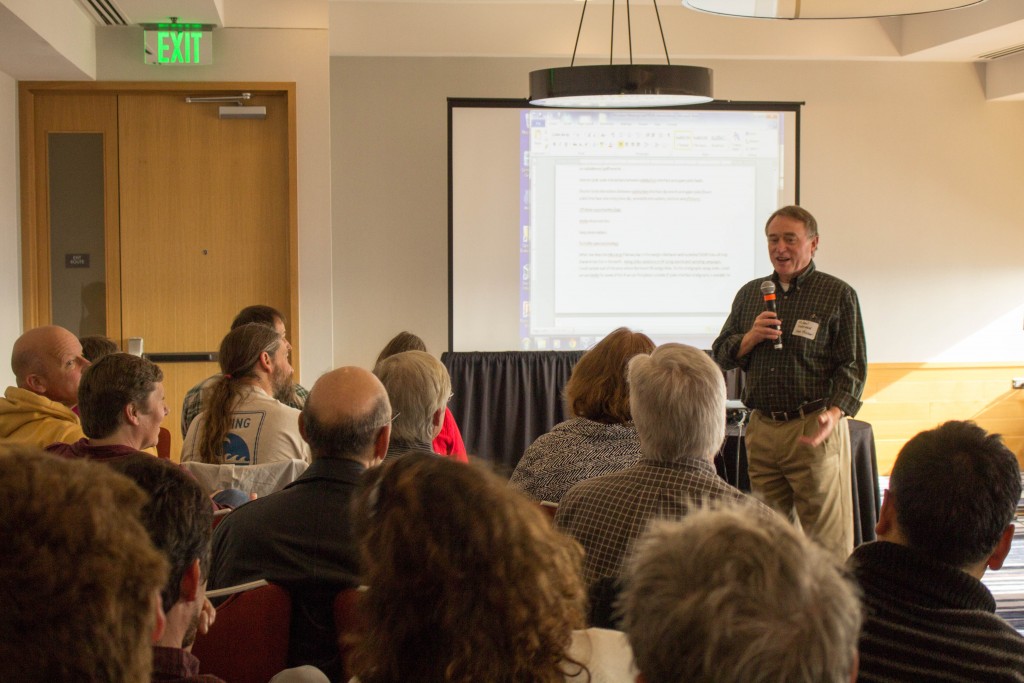AGU Fall Meeting 2014, San Francisco, USA
1UTIG, Austin; 2University of Missouri; 3Scripps Institution of Oceanography, UC San Diego; 4GNS Science, NZ

Mike Underwood, one of the conveners of the Hikurangi Mini-Workshop, leading discussion on Sunday morning
On Sunday, December 14, 2014, an enthusiastic group of more than 70 international researchers from a variety of disciplines met in San Francisco at AGU to discuss studies that should be proposed at the Hikurangi subduction margin (part of the New Zealand focus site) for the upcoming GeoPRISMS funding rounds. The meeting began with a brief overview of the GeoPRISMS program by Peter van Keken, which was followed by Mike Underwood’s review of the Hikurangi margin science priorities, which are based largely on discussions at the New Zealand Focus site workshop that was held in April 2013. The objective of the mini-workshop was to promote and coordinate new collaborations to fill critical gaps in the GeoPRISMS Implementation Plan. To that end, a series of short talks highlighted projects that are either ongoing, already proposed, or soon to be proposed. The last half of the meeting was focused on open discussion during which participants identified new research opportunities.
The community has already made major progress in advancing key science objectives identified for the Hikurangi margin. Demian Saffer overviewed the IODP drilling proposals to investigate shallow slow slip events (SSEs) at the northern Hikurangi margin; the proposal for riserless drilling has passed through panel reviews and now awaits scheduling by the JOIDES Resolution Facilities Board. A proposal for riser drilling also reviewed well and has been forwarded to the Chikyu Facilities Board. Already underway is the Hikurangi Ocean Bottom Investigation of Tremor and Slow Slip (HOBITSS) to investigate vertical deformation of the seafloor and seismicity related to the shallow SSEs, supported by funding from NSF, New Zealand, and Japanese sources. An NSF-funded heat-flow survey led by Rob Harris is scheduled for May/June 2015 to constrain the thermal regime of the subduction interface. Proposals have been submitted to NSF to (1) acquire 3-D seismic data of the shallow SSE source, (2) conduct onshore and offshore geophysical investigation of megathrust properties along-strike, and (3) to install long-term borehole observatories at the proposed IODP sites.
Numerous representatives from the New Zealand geoscience community introduced ongoing and planned geophysical, geological, and modeling initiatives that dovetail nicely with GeoPRISMS goals. In particular, there are a large number of seismological, electromagnetic (onshore), numerical modeling, and paleoseismological investigations conducted by New Zealand-based researchers. To leverage these existing and planned studies (and not duplicate efforts), it is particularly important for GeoPRISMS-funded investigators to collaborate with and communicate with their New Zealand-based counterparts. David Johnston of GNS Science informed participants about a New Zealand-based initiative called “East Coast Life at the Boundary (LAB)”, part of which is targeted at communication of research results on the Hikurangi margin to the general public and local policymakers. This offers an excellent opportunity for GeoPRISMS researchers at Hikurangi to work with the East Coast LAB to coordinate outreach activities in New Zealand. We also heard about ongoing and already funded efforts by Japanese and European researchers focused on the offshore Hikurangi margin over the next four years.
The last half of the mini workshop was dedicated to discussion of critical science gaps. The main discussion focused on:
- microseismicity, episodic slow slip, and tremor;
- the state of the incoming plate and the role of incoming sediment properties in subduction thrust behavior and margin evolution;
- past and present megathrust slip behavior and the physical controls on that behavior;
- fluid and volatile fluxes in the forearc.
From this discussion we identified some of the most critical studies that are needed to fill gaps. Paleoseismology studies will help resolve the past earthquake behavior of the subduction thrust and whether or not the modern-day geodetic locking pattern is static or varies with time. Increased efforts towards sampling and geochemical analysis of onshore and offshore fluid seeps will yield important insights into volatile cycling and hydrogeology above a shallow subduction thrust. A new idea was raised to use the seafloor drill rig MeBo for coring at numerous points on the Hikurangi Plateau (a Large Igneous Province) where the sedimentary cover is thin (<200 m). Such sampling would address the role of 3-D stratigraphic variability in modulating subduction-interface slip behavior. Controlled-source electromagnetic (CSEM) transects in the offshore forearc and incoming plate will evaluate the role of fluids in megathrust slip behavior and margin evolution. Seafloor (GPS-Acoustic) geodetic studies will help resolve the slip behavior of the shallow subduction thrust. Densification of onshore geodetic instrumentation, and addition of strain meters, tiltmeters, and borehole seismometers will lower the threshold of slow slip event detection, enabling higher-resolution investigation of SSEs and seismicity, and detection of smaller events. Modeling of Hikurangi SSEs assuming a rate-state friction framework, as well as other approaches, will help resolve the physical controls on the diversity of SSE behavior.
The conveners appreciate the participants’ contributions, and thank them for their help in achieving the goals of the mini-workshop.
Go to the Mini-Workshop webpage
Reference informationGeoPRISMS Newsletter, Issue No. 34, Spring 2015. Retrieved from http://geoprisms.nineplanetsllc.com
